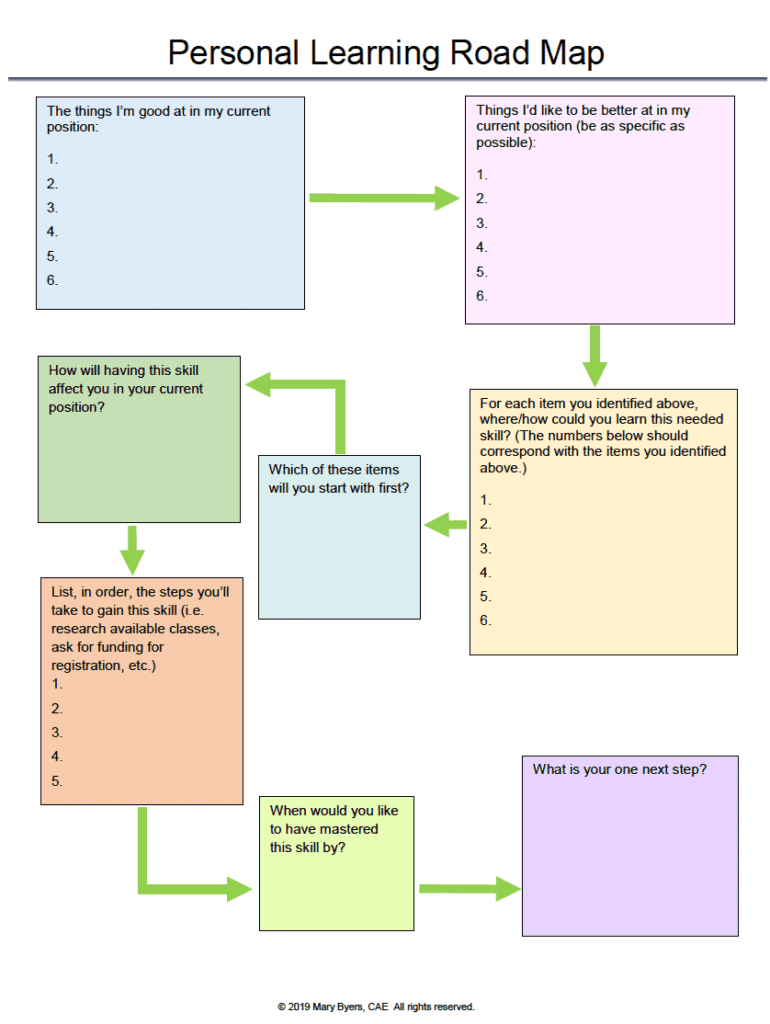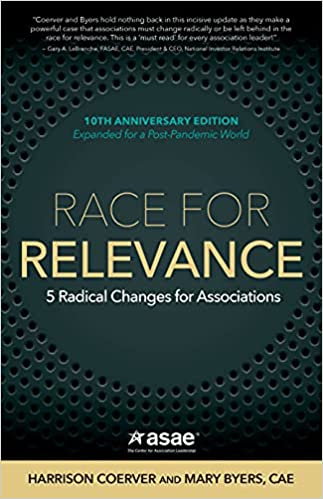This podcast series is our attempt to offer a theoretical learning business MBA program, and we invite you to play along. Imagine you’re in business school and about to hear a guest lecture by Mary Byers, a speaker, facilitator, consultant, and author of several books, including Race for Relevance: Five Radical Changes for Associations. She’s also host of the Successful Associations Today Podcast. Her work centers on helping organizations remain relevant in a rapidly changing environment, and her main area of interest is innovation and evolution in all things—organizationally, educationally, and otherwise.
In this third episode in our seven-part learning business MBA series, Celisa talks with Mary about what it takes to succeed as a learning business and her related thoughts around innovation and continuous evolution. They discuss the idea of shrinking to grow, why organizations need a digital-first mindset, and the importance of a go-forward strategy.
To tune in, listen below. To make sure you catch all future episodes, be sure to subscribe via RSS, Apple Podcasts, Spotify, Stitcher Radio, iHeartRadio, PodBean, or any podcatcher service you may use (e.g., Overcast). And, if you like the podcast, be sure to give it a tweet.
Listen to the Show
Access the Transcript
Download a PDF transcript of this episode’s audio.
Read the Show Notes
[00:31] – Intro and background info about Mary
What it Takes to Succeed as a Learning Business
[02:04] – What do those leading and working in a learning business need to know or be able to do to be successful?
Mary mentions three things:
- Be committed to continuous evolution. Complacency leads to irrelevance.
- Be comfortable launching small pilots and recalibrating if necessary. Flexible organizations are successful organizations.
- Be comfortable dancing with uncertainty. We dance with uncertainty all the time, and the more we lean into that and acknowledge it, the more realistically we’ll approach our work.
[04:11] – Out of the skills, knowledge, and behaviors you just mentioned, where do you typically see learning businesses struggle, and where are they more open to embracing that attitude or mindset?
Where we struggle is in keeping the pedal to the metal on continuous evolution and being comfortable with small pilots and recalibrating when necessary. We also struggle in the area of risk tolerance.
We can’t move our educational efforts forward if we do the same things in the same way. So much has changed. Whether you’re talking about in-person learning, online learning, or a combination of the two, we just have to be more aggressive overall, period.
Mary Byers
Where we often excel—and these aren’t things that actually help us—is in protecting the status quo, in meeting deadlines, and doing the comfortable things. We need to get comfortable with discomfort, especially going forward in the educational arena.
[05:53] – When you think about the skills and behaviors that it takes for organizations to succeed, is there a hierarchy? If so, which ones are the most important?
The willingness to experiment is one of the most important, but that comes along with risk and no guarantees. Because we’re not comfortable with uncertainty, there’s tension between those two things. Many cultures don’t support this aspect of innovation and reward consistent performance instead.
[06:38] – How do you see organizations helping their internal team get the needed skills, knowledge, behaviors, and mindset to succeed?
The ones that are doing it well are being very intentional and deliberate about having conversations related to needed skill sets. Mary suggests each team member should have a personal learning roadmap for two reasons:
- If you’re an educational organization and you believe in continuing education, you should walk the talk and make sure your employees are engaged in continuous education.
- It’s a way to be intentional and deliberate and to have a plan each year for what we need to learn, how to do it, and where to get the necessary resources.
Complacency leads to irrelevance…. A lot of times we think of employees as serving our learners externally, but we also need to think about employees as learners internally as well.
Mary Byers
Sponsor: Cadmium
[10:02] – If you’re looking for a partner to help you make continuous learning a reality, check out our sponsor for this series.
The COVID-19 pandemic catalyzed the merging of events and education for organizations across the globe. Organizations have realized that synergizing their education and events strategies produces immeasurable benefits, but they need a technology solution that facilitates that merge.
Cadmium is focused on providing a full suite of technology solutions enabling organizations to meet the changing environment head on. From a host of event technologies to integrated learning management and content creation tools, Cadmium offers everything an organization needs to generate revenue and drive engagement.
Learn more, and request a demo to see how Cadmium can help your learning business at gocadmium.com.
Role of Data in Organizational Decision-Making
[11:02] – This is a concept that you talk about in your book Race for Relevance. What is the role you see data playing to help organizations make decisions?
As we’re talking about experimenting and innovation, if we are using data, we are taking less risk because we’re not just guessing. We’re using what we know to be true to help identify new opportunities such as potential new topics that people are interested in for their own learning.
Data is important because it can help you meet learner needs more efficiently. It can create efficiencies internally as well. However, data isn’t always sexy, and Mary thinks that’s one of the reasons it’s underutilized. The second reason is we aren’t set up to capture data, and, even if we have the data, we don’t always use it. Also, sometimes we have data that we don’t even know we have.
To look at data effectively, you need people who are skilled enough to be able to interpret it and help you make sense of it. They need to help you identify trends that the data is showing you and help you make decisions based on what you know to be true rather than what you think or hope to be true.
Understanding Cost
[14:49] – How should organizations go about understanding the cost of the programs that it offers?
It is not enough to look at the direct cost; we have to consider overhead and staff time as well. But many organizations are not set up to track this, so it isn’t easy. Sometimes we don’t give ourselves the freedom and flexibility to step back and assess staff time, even at a very simple level. Therefore, many organizations think they’re making money on a product or program, but, if they accounted for overhead and staff time, they’d find they really aren’t profitable. We have to be more deliberate and intentional about tracking our costs so that we get a true picture of whether we’re making money, breaking even, or actually losing money on some of our offerings.
Volume Doesn’t Equal Value
[16:28] – Would you talk a bit about the arguments that you see for an organization having a narrower product and service line?
The Pareto Principle (also known as the 80/20 rule) tells us that 80 percent of value comes from 20 percent of programs. For a learning business, this means that a few of its programs are going to be the most popular and likely provide the most revenue. This means that you could lean into 20 percent of your programs and probably be more profitable right off the bat.
We’re very slow to retire programs, and that leads to educational clutter…. We need to think about regularly, purposely abandoning less popular or dated courses.
Mary Byers
Besides retiring less popular and dated courses, Mary recommends leaders consider the following to increase both revenue and impact for learners:
- Have a strong search function so that prospective learners can find what they’re looking for quickly and easily (without having to hunt through layers and years of programming).
- Consider creating packages so that if a learner buys one thing, they can get other related material for one fee.
- Think about learning pathways or learning journeys so that once learners have started with an area of interest, you’re able to recommend what they can do next.
The bottom line is to not make your learners work to learn with you. Help them access your programs, services, and curricula.
[20:28] – One of the ideas from Race for Relevance deals with opportunity cost. When you pursue more than you should, that means you don’t have bandwidth or resources to pursue something else.
If you’re busy doing one thing, you can’t be doing another—and if the “another” could hold more value for your audience, that is a sad way to use resources. We want to be using resources, like time, at the highest and best use, not only for your curriculum developers but also for your learners. You also want to make sure there’s a good match between what you’re offering and what learners desire.
Regarding sunk cost, a lot of the times we won’t abandon, sunset , or retire a program because we have a high level of sunk cost in them, and we want to keep going to turn a profit. That’s why experimenting is so important. If you put a small piece of learning out there, and nobody’s interested, you don’t have to build it out. You can go on to find the next piece of learning that somebody would be interested in. That approach keeps your sunk costs low, making it easier to abandon a program when needed.
A Digital-First Mindset
[22:08] – How you would describe a digital-first mindset, and what would that look like in the context of a learning business?
Mary defines a digital-first mindset as embracing technology in order to deliver what learners want, when they want it, and how they want it. And that doesn’t mean only in a virtual environment. A digital-first mindset is understands that technology also plays a role even when you’re meeting in person. A digital-first mindset requires a close relationship with your audience, constantly asking them, listening to them, and inviting input.
Many organizations are behind in building a robust technology framework. That may be due to lack of money or lack of expertise, or it could be as simple as they’re intimidated. The reality is that none of us has time to embrace or create a digital-first mindset while we’re doing the work of today’s business. We have to have two-horizons thinking—short-term, immediate deadlines and long-term deadlines focused on the infrastructure and technology needed to support the learning business’s mission and learners.
When we hold hybrid events, we need to consider the needs of the two audiences. There are certainly places where they intersect, but we have to be cognizant of what our goal is and then work backwards to figure out how to best meet that. We need to be thinking not just about the online experience but how technology can support the in-person experience as well.
Check out our related article “Hybrid vs. Blended Learning: The Difference and Why It Matters.”
Advice for Learning Businesses
[25:34] – What advice do you have for a learning business that is looking to grow and to move up to the next level?
Mary encourages thinking about three things:
- Don’t wait to determine and articulate your strategy. Put it in writing, share it with your team, and make that the focus of your longer-horizon thinking because the decisions and actions you take today will determine where you’re going to be in the future.
Watch the video to see what Mary says is a secondary benefit of strategic planning.
- Be prepared to invest and invest regularly. Investment involves not just money but also time and expertise. Areas and efforts that are under-resourced or inadequately resourced often fail.
- Consider finding collaborative partners. In many cases, the expertise we need to grow exponentially isn’t necessarily on staff, but a collaborative partner (whether a vendor or another organization) has it. Collaboration is the new currency.
[29:40] – Mary adds that sometimes the data from an early experiment isn’t mature enough to be helpful. She tells people not to pull the plug too soon, especially if you’re launching something new that’s never been tried before. Also, the more you do it, the more you can get testimonials, social proof, and social media working so you can promote the new initiative, and then momentum may take off. Although there is a time to retire, sunset, and purposely abandon, it’s not always right after your first attempt trying something new.
[31:07] – Mary encourages listeners to think about developing a go-forward strategy.
We hear a lot about going back to “normal,” going back and just doing things the way that we used to.… But I’m encouraging anytime you hear the words “go back” out of your mouth to gently switch that and change it to “go forward” because “go forward” is positive and optimistic and forward-looking and forward-thinking. Those words “go forward” just have power and momentum and energy in them. And that’s what all learning organizations need to have. They need to be looking further down the horizon than anybody else is.
Mary Byers
[32:15] – Wrap-up
To make sure you don’t miss the remaining episodes in the series, we encourage you to subscribe via RSS, Apple Podcasts, Spotify, Stitcher Radio, iHeartRadio, PodBean, or any podcatcher service you may use (e.g., Overcast). Subscribing also helps us get some data on the impact of the podcast.
We’d also appreciate if you give us a rating on Apple Podcasts by going to https://www.leadinglearning.com/apple.
We personally appreciate your rating and review, but more importantly reviews and ratings play a big role in helping the podcast show up when people search for content on leading a learning business.
Finally, consider following us and sharing the good word about Leading Learning. You can find us on Twitter, Facebook, and LinkedIn.
Other Episodes in This Series:
Episodes on Related Topics:





 The Strategy and Marketing Episode
The Strategy and Marketing Episode
Leave a Reply